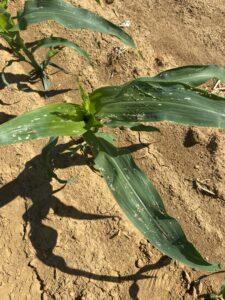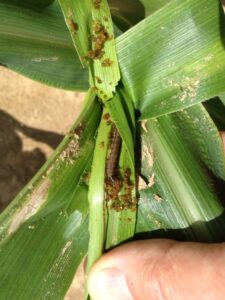A Certified Safety and Health Official (CSHO) from OSHA inspected a farm during the third week of June in Southern NJ for heat related items. With this recent inspection activity and the current legislative landscape pertaining to heat stress, the Rutgers Farm Health and Safety Working Group has increased outreach and education on this topic. Resources on heat stress prevention from Rutgers are available in many formats for farmers.
Please take some time to review the NJAES Heat Stress and Agriculture website which features resources and tools from NJAES, OSHA, and the National Weather Service on heat stress mitigation. The Rutgers Working Group will continue to add new resources as they become available. These tools may aid farmers in their proactive efforts to manage heat stress.
As you review these resources, please realize strengthening your heat stress management practices may also help in preparedness for activities conducted during an OSHA heat-related inspection:

USDA Photo by Kirsten Strough.
- Review OSHA 300 Logs for any entries indicating heat-related illness(es),
- Review injury and illness reports and obtain any records of emergency room visits and/or ambulance transport, even if hospitalizations did not occur,
- Interview workers for reports of headache, dizziness, fainting, dehydration, or other symptoms that may indicate heat-related illnesses,
- Review employer’s plan to address heat exposure, including acclimatization procedures (especially for new and returning workers), work-rest schedules, access to shade and water (with electrolytes/sports drinks when needed), and any training records associated with a heat illness prevention program,
- Document, where possible, the heat index on the OSHA-NIOSH Heat App, using the screen save feature on a mobile phone or tablet, or keep other forms of these records,
- Identify conditions and activities relevant to heat-related hazards. These can include, but are not limited to:
- Potential sources of heat-related illnesses (e.g., working in direct sunlight, in a hot vehicle, or areas with hot air, near an engine, furnace, boiler or steam lines),
- Wet Bulb Globe Temperature (WBGT) calculations and/or other temperature measurements,
- Heat advisories, warnings or alerts,
- The use of heavy or bulky clothing or equipment,
- The types of activities performed by the employees and whether those activities can be categorized as moderate, heavy or very heavy work,
- The length of time in which a worker is continuously or repeatedly performing moderate to strenuous activities,
- Heat-related illnesses among new workers,
- The presence of any recent vacation time or breaks in employment prior to complaints of heat-related symptoms, and
- The availability of rest breaks, water and shade on site.
Article By: The Rutgers Farm Health and Safety Working Group: Kate Brown, Michelle Infante-Casella, Stephen Komar and William Bamka


